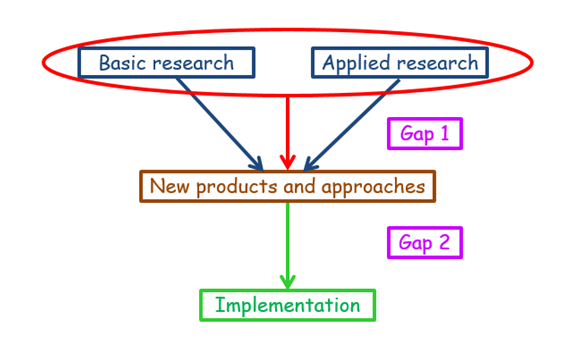A clear definition of translational research is hard to come by. Typical general definitions include:
• the process of transferring, from bench to bedside, findings in basic science into clinical practice, e.g. diagnostic procedures and therapeutic concepts.
• the application of biomedical research (pre-clinical and clinical), conducted to support drug development, which aids in the identification of the appropriate patient for treatment, the correct dose and schedule to be tested in the clinic, and the best disease in which to test a potential agent.
• research that transforms scientific discoveries arising in the lab, clinic, or population into new clinical tools and applications that reduce cancer incidence, morbidity, and mortality.
• the movement of discoveries in basic research (the Bench) to application at the clinical level (the Bedside).
• successful integration of scientific discoveries in the treatment of human disease.
These and other definitions, technically known as intensional definitions, are in general unsatisfactory; they are either too non-specific or in some cases too focused. An operational definition would be more satisfactory and explanatory.
I shall start my approach to an operational definition of translation research by considering the definitions of basic, applied, and translational research that were included in the 2006 Cooksey report, A Review of UK Health Research Funding:
• Basic research, also referred to as “fundamental” or “blue skies” research, asks questions about health and disease without any primary driver for practical application. It is driven by a quest for knowledge via scientific study rather than addressing specific clinical needs and has traditionally been the preserve of laboratory based researchers at universities or research institutions.
• Applied research covers a wide range of research, primarily involving human volunteers (either diseased or healthy volunteers). It includes research into the prevention, detection, and diagnosis of disease and the development of interventions (effectively most of “clinical research”); the evaluation of interventions (e.g. Health Technology Assessment); the management of disease; and the provision of health and social care services. It is driven by the desire to answer a specific health related question, need, or desire to improve services or care.
• Translational research refers to the process of taking the findings from basic or clinical research and using them to produce innovation in healthcare settings. Translational research can also be used to define research that involves both basic and applied research: the research at the interface between the two ends of the research spectrum, which can include both laboratory and clinic based aspects.
Cooksey then described two major gaps in translating basic and clinical research into applied outcomes, illustrated in the model below:
• Gap 1: Translating ideas from basic and clinical research into the development of new products for and approaches to the treatment of disease and illness.
• Gap 2: Implementing those new products and approaches into clinical practice.

Figure. An early operational definition of translational research, based on Cooksey’s definitions of basic and applied research and the gaps between research and its outputs and implementation
However, there are problems with this model. Firstly, it assumes a strict dichotomy between basic and applied research, whereas the idea of translation implies no clear distinction of that type. Secondly, it depicts translation as a linear process, assuming one way arrows linking successive parts of the model directly, ignoring the feedback loops that two way processes, like bridges, enjoy. Furthermore, it does not take into account the possibility of connections between more remote parts of the model—for example, the ways in which the results of implementation can stimulate further research, both basic and applied.
Next week I shall start to develop an improved approach, suggested by combining several other definitions, each of which has extended the concepts developed by its predecessors.
 Jeffrey Aronson is a clinical pharmacologist, working in the Centre for Evidence Based Medicine in Oxford’s Nuffield Department of Primary Care Health Sciences. He is also president emeritus of the British Pharmacological Society.
Jeffrey Aronson is a clinical pharmacologist, working in the Centre for Evidence Based Medicine in Oxford’s Nuffield Department of Primary Care Health Sciences. He is also president emeritus of the British Pharmacological Society.
Competing interests: None declared.
